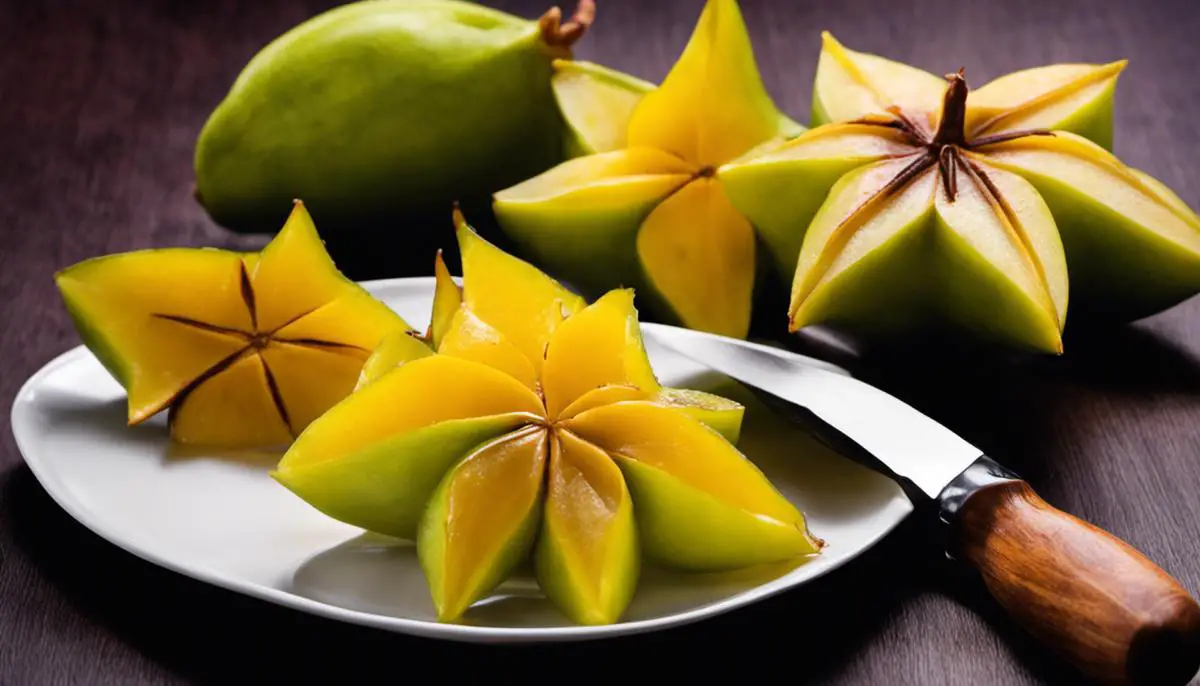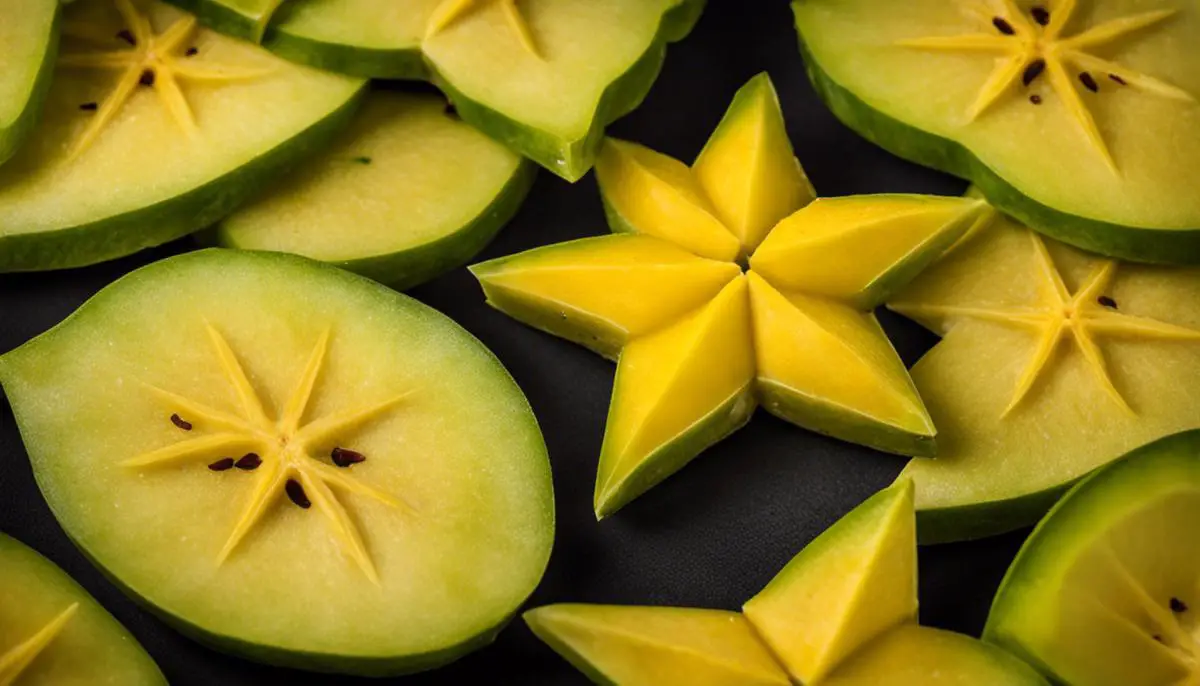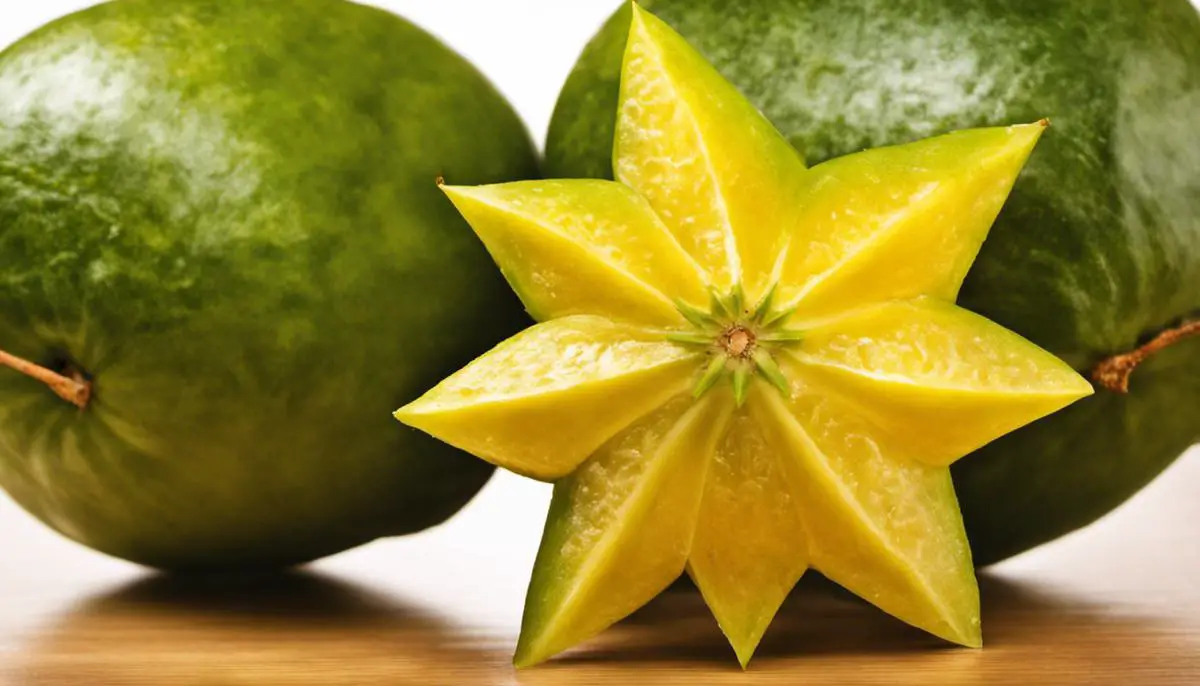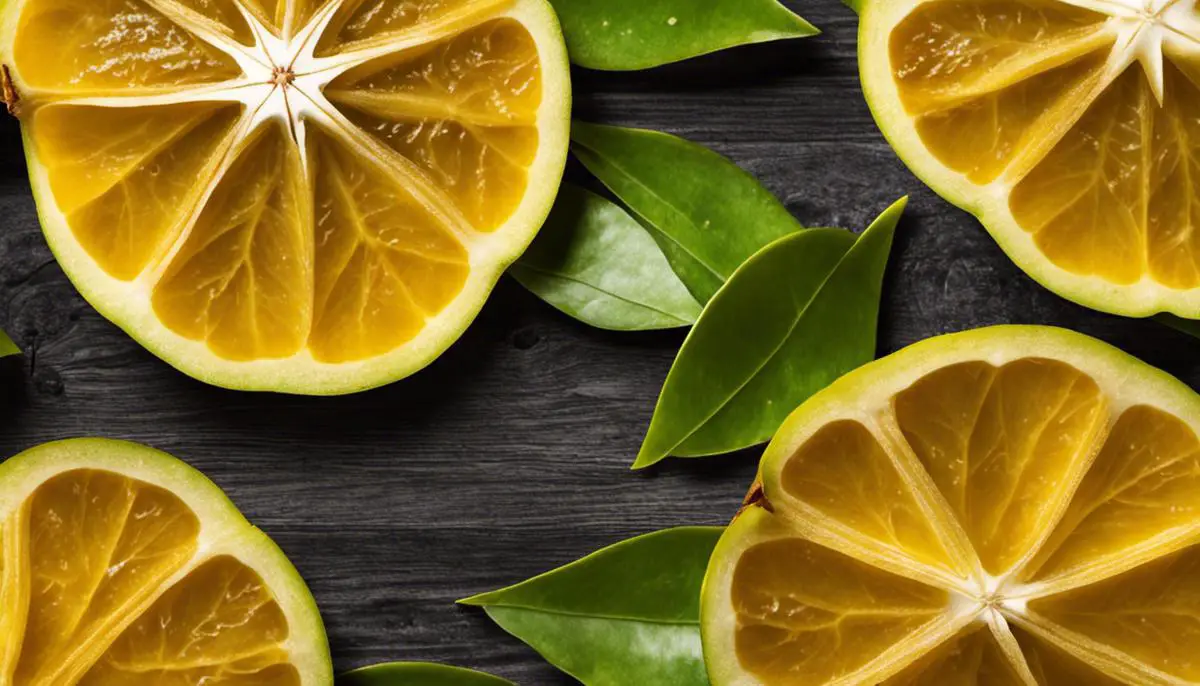Ensuring good digestive health is a key focus for many people seeking to improve their overall wellbeing. The diverse world of fruits offers a wealth of options to support this goal, and one such fruit is the carambola, or star fruit as it’s often known. This essay dives deep into the role of carambola in digestion, its nutritious profile, and practical methods of incorporating it into daily meals. As a bonus, insights into understanding the complexity of the human digestive system and its intricate functions will also be part of the exploration. However, like anything else consumed, it’s essential to be aware of the safety precautions and potential side effects. This essay provides a comprehensive package of relevant and useful knowledge for anyone looking to enhance their digestive wellbeing with carambola.
Understanding Digestion
Understanding the Digestive Process
Digestion begins in the mouth where the mechanical process of chewing breaks down food into smaller pieces. Enzymes in saliva also start the chemical process of transforming starches into simple sugars. Food then travels down the esophagus and into the stomach. Here, gastric acid and enzymes mix with the food to break it down further into a liquid substance called chyme.
The chyme then enters into the small intestine, a lengthy tubular organ where the majority of digestion and absorption occurs. Pancreatic enzymes break down proteins, fats, and carbohydrates, while bile from the liver aids in fat digestion. The inner lining of the small intestine absorbs the broken down nutrients into the bloodstream for the body to utilize for energy, growth, and cell repair.
The leftover water, dietary fiber, and other indigestibles move to the large intestine or colon. There, beneficial bacteria ferment some of the fibers producing short-chain fatty acids that also provide us with some nutritional benefits.
Carambola and Digestive Health
Carambola, more commonly known as star fruit, can play a significant role in improving the digestive process. This tropical fruit is high in dietary fiber, which aids digestion by adding bulk to the stool. This can help prevent digestion-related issues like constipation, bloating, and irregular bowel movements.
The fruit’s fiber content also acts as a prebiotic, providing nourishment for beneficial gut bacteria. A healthy gut microbiome plays a key role in the overall digestive process and can help enhance nutrient absorption in the intestines.
Furthermore, carambola is packed with water, which aids in softening the stool and promoting regular bowel movements. This not only helps maintain a healthy digestive system but can also reduce the risk of hemorrhoids and diverticulitis.
Key Nutrients in Carambola
In addition to its high fiber content, carambola is a great source of other nutrients that support digestion. It is rich in vitamin C, a powerful antioxidant that can aid in repairing the tissues lining the digestive tract. The fruit also contains essential minerals such as magnesium and potassium, which are needed for muscle contractions that move food through the digestive tract.
Additionally, carambola provides several B-vitamins that are involved in metabolism and converting food into energy. In particular, the fruit is a good source of thiamine (vitamin B1), which is essential for breaking down carbohydrates.
Integrating carambola into your daily nutritional intake could greatly improve your digestive health. Renowned for its high fiber content and essential nutrients, it facilitates an effective digestive system, enhances the absorption of nutrients, and stimulates regular bowel movements. Nevertheless, it’s crucial to enjoy this fruit in moderation due to its high oxalic acid content, which could contribute to kidney stones for those susceptible to this condition.

Carambola – An Overview
Understanding Carambola’s Origin and Cultivation
Renowned for its distinct star-shaped cross-section, carambola, or star fruit as it’s more commonly referred to, originates from tropical regions such as Southeast Asia, the South Pacific, and East Asia. Globally, it has found a home in diverse regions ranging from the Caribbean to Latin America, and even the southern parts of the United States, particularly Florida. Favorable in warm climates, the fruit-bearing tree flourishes year-round, reaching heights of up to 30 feet.
Nutritional Analysis of Carambola
The star fruit is composed primarily of water (about 91%) and carbohydrates, with a small amount of protein and minimal fat. But, what makes the fruit noteworthy is its impressive lineup of essential nutrients. While low in calories, carambola is rich in antioxidant vitamin C and loaded with fiber. A one-cup serving of star fruit provides around 3 grams of dietary fiber. It also contains other vital nutrients such as vitamin A, folate, and potassium.
Carambola’s Impact on Digestive Health
Increasing fiber intake is one of the most effective ways to promote a healthy digestive system, and carambola can help in this regard. As a high-fiber food, carambola aids in maintaining bowel regularity by adding bulk to your diet. This can help alleviate constipation and support regular bowel movements. Furthermore, dietary fiber also feeds the beneficial gut bacteria, playing a critical role in the balance of the gut microbiota, which is pivotal for overall gut health.
Taste and Culinary Uses of Carambola
The taste of carambola is unique due to its sweet and tart flavor combination, often compared to a blend of apple, pear, grape, and citrus fruit. The texture is juicy and crunchy, similar to an apple. Its distinctive star shape when sliced crosswise makes carambola an attractive garnish or addition to salads, cocktails, and desserts. It pairs well with other tropical fruits like coconut and mango in fruit salads or smoothies. The fruit can also be cooked and incorporated into stir-fried dishes, sweet-and-sour dishes, and even made into jams or chutneys.
Things to Note About Carambola
Whilst carambola – better known as star fruit – offers many health benefits, its consumption comes with some caution. Particularly for those suffering from kidney diseases, the neurotoxin contained in carambola can pose a potential risk. It is therefore advised that individuals with kidney problems or those undergoing dialysis should either avoid this fruit or consume it judiciously. It is always advisable to consult with a healthcare professional before embarking on a new dietary routine, particularly if you have underlying health issues.

Carambola’s Role in Digestion
The Power of Carambola on Digestion
With its vibrant flavor and unique shape, carambola, or star fruit, has secured a prominent place in healthy diets due to its array of benefits. One of these advantageous effects is its positive impact on digestive health. This benefit hinges on the rich dietary fiber and enzymes present in carambola. As you consider diversifying your diet, remember carambola’s digestive benefits.
Understanding the Role of Fiber in Carambola
Dietary fiber is an essential part of a healthy diet. It adds bulk to the diet, assisting in the movements of material through the digestive system, thereby preventing constipation. Carambola is a good source of fiber, providing about 2.8 grams per 100-gram serving.
Fiber also feeds the gut-friendly bacteria in your intestine. These bacteria produce nutrients for your body, some of which can help reduce inflammation in the gut and improve digestion. More recent advances in nutrition science suggest that dietary fiber can also help protect against the development of digestive conditions like ulcers, reflux, hemorrhoids, diverticulitis, and IBS (Irritable Bowel Syndrome).
Unlocking the Power of Enzymes in Carambola
Interestingly, carambola also contains multiple types of digestive enzymes such as protease, amylase, and lipase. Digestive enzymes break down complex foods into smaller components, facilitating the process of digestion.
Amylase, for instance, is responsible for breaking down starches into sugars, aiding in the digestion of carbohydrates found in many foods. Lipase works on fats and breaks them down into their constituent parts – glycerol and fatty acids – which are easier for the body to absorb. Protease focuses on protein breakdown, converting proteins into amino acids essential for body growth and repair.
These naturally occurring enzymes in carambola enhance the body’s digestion capabilities. When you consume star fruit, these enzymes are released, assisting in breaking down foods in the stomach and intestine.
Prebiotic Potential of Carambola
Carambola could also be considered a prebiotic due to its fiber content. Prebiotics are specialized plant fibers that beneficially nourish the good bacteria already in the colon or large intestine. By eating carambola, you’re essentially feeding millions of good bacteria in your gut, promoting their growth. This could lead to improved digestion, better immune function, and other health benefits.
Essentially, the fiber and digestive enzymes present in carambola work synergistically to create a healthy gut environment, allowing for an efficient digestion process.
Carambola Consumption Guidelines
Carambola, commonly known as star fruit, is known for its unique flavor and notable health benefits, especially in relation to digestion. However, as with most food, it’s important to consume it in moderation. Especially for those with kidney conditions or on prescribed medication. This is due to the presence of oxalic acid and caramboxin in excessive amounts. If you have an allergy to this fruit, it’s best to steer clear of it.
In conclusion, the high fiber content and the presence of multiple digestive enzymes in carambola aids in enhancing your gut health and overall digestion efficiency. Remember to always adhere to a moderate consumption pattern and to take into account your personal health conditions and potential food allergies.

How to Incorporate Carambola into Your Diet
Digestive Benefits of Carambola
The unique star-shaped fruit, Carambola, holds within it numerous health benefits. One of its key advantages lies in its ability to positively influence our digestive system. The dense fiber content within the fruit assists in the improvement of digestion, giving your diet the much-needed bulk. It also facilitates the smooth movement of food through your digestive tract, preventing constipation effectively.
Incorporating Carambola into Salads
One of the easiest ways to include carambola in your everyday meals is to use it as part of your salad. You can simply add chopped carambola in your usual greens or create a tropical-themed salad by pairing it with other exotic fruits like mango and papaya. A sprinkle of lime and a drizzle of honey on the salad can further enhance the taste while also augmenting the health benefits.
Utilizing Carambola as a Juice Ingredient
Another practical way to incorporate carambola into your daily routine is to use it in juicing. It can be mixed with other fruits or vegetables that are beneficial for digestion, like apple, pineapple, or ginger. When juiced and consumed, it acts as a natural remedy to soothe the digestive system. Additionally, carambola juice can also be a refreshing and healthy alternative to sugary drinks.
Using Carambola in Cooking
For those who prefer cooked meals, carambola can be an excellent addition to various dishes. Sauteed carambola can be served as a side dish or used as a tangy topper for fish or grilled chicken. Carambola also works well in stir-fries. Its unique sweet and sour flavor pairs nicely with many Asian recipes. Moreover, the cooking process does not significantly affect the fiber content in carambola, thus maintaining its digestive advantages.
Carambola in Desserts
Using carambola in desserts is another fantastic way to incorporate it into your diet. For instance, carambola can be baked into a pie or used as a topping on a tart. Its sweet, slightly tart flavor can balance out the richness of desserts, making it a unique twist on classic recipes. Just remember to keep the sugar content in check if you’re aiming for better digestion.
Straightforward Carambola Snacking
Lastly, carambola can simply be consumed as a healthy snack. Since it’s already conveniently shaped like a star when sliced, it’s a fun and attractive way to snack. It’s delicious on its own, or you can pair it with a dip, like hummus or a yogurt-based dip, to add protein and make the snack more fulfilling.
If you’re seeking a natural way to support and maintain a healthy digestive system, the tropical carambola fruit, often incorporated into a variety of meals and snacks, may offer an appealing solution. Its versatile nature allows it to be enjoyed in salads, beverages, main dishes, desserts, or simply on its own. Above all, it is revered for its potential to aid digestion.

Safety and Potential Side Effects
Delving Deeper into Carambola Fruit
Carambola, fondly known as star fruit for its distinctive shape, hails from the tropical regions of Southeast Asia. This fruit is a powerhouse of vital nutrients like vitamins A, C, E, potassium, dietary fiber, and antioxidants, all of which champion a healthier diet. While it’s celebrated for an array of benefits, one aspect typically stands out—its ability to enhance digestion. That being said, it’s important to consider that carambola may not be suitable for everyone due to potential health concerns.
Risks for Kidney Patients
While carambola is often hailed for its health benefits, it can pose significant health risks to people with compromised kidney function due to the oxalic acid it contains. The fruit contains a high level of oxalate, making it dangerous for persons with kidney problems. The risk is especially high for individuals with chronic kidney disease or those on dialysis, as their kidneys may not be able to remove the excess oxalic acid from the body. This build-up could lead to a condition known as oxalate nephropathy, which can cause kidney failure.
Potential Neurotoxicity
Carambola also has neurotoxic potential. Individuals with kidney impairment have a higher risk of developing neurotoxic effects due to the large concentration of caramboxin, a compound in the fruit. This toxin can’t be effectively removed by damaged kidneys, leading to accumulation in the bloodstream and eventually to the brain. Symptoms may include confusion, seizures, and even life-threatening outcomes.
Carambola and Drug Interactions
The fruit is also known to interfere with certain medications. Carambola contains compounds that inhibit the activity of CYP3A4, an enzyme vital in the metabolism of many medications. For individuals taking drugs like statins, benzodiazepines, or calcium channel blockers, consuming carambola could disrupt the normal breakdown of these medications in the body, potentially leading to adverse reactions or diminished effectiveness of the drugs.
Moderation is Key
For individuals who do not have kidney issues and are not on the aforementioned medications, carambola can still be part of a balanced diet and might even contribute to better digestion. Its high fiber content can aid in promoting regular bowel movements and reducing the risk of constipation. However, as with any food, consuming it in moderation is key. An excessive intake of any fruit, including carambola, could potentially lead to digestive problems due to its high fiber content.
It is always crucial to be aware of one’s health condition before incorporating any new food into the diet. When in doubt, consult with a healthcare professional. A healthy diet is indeed a personalized one – what’s healthy for one individual may not be the same for another.

With the inclusion of carambola into one’s diet, improving digestion and bolstering health can be deliciously achieved. The star fruit’s impressive nutritional profile and its potential benefits for digestive health make it an appealing choice, both for those who enjoy its unique taste and those seeking healthier dietary choices. However, interconnected with these benefits lies the necessity of moderation and understanding potential risks. Being aware of who should be cautious with carambola consumption ensures its benefits can be enjoyed safely and healthily. So, as you contemplate adding more carambola to your meals, remember the journey of understanding digestion, the insightful overview of carambola, its role in digestion, safety, and side effects to make an informed choice.
